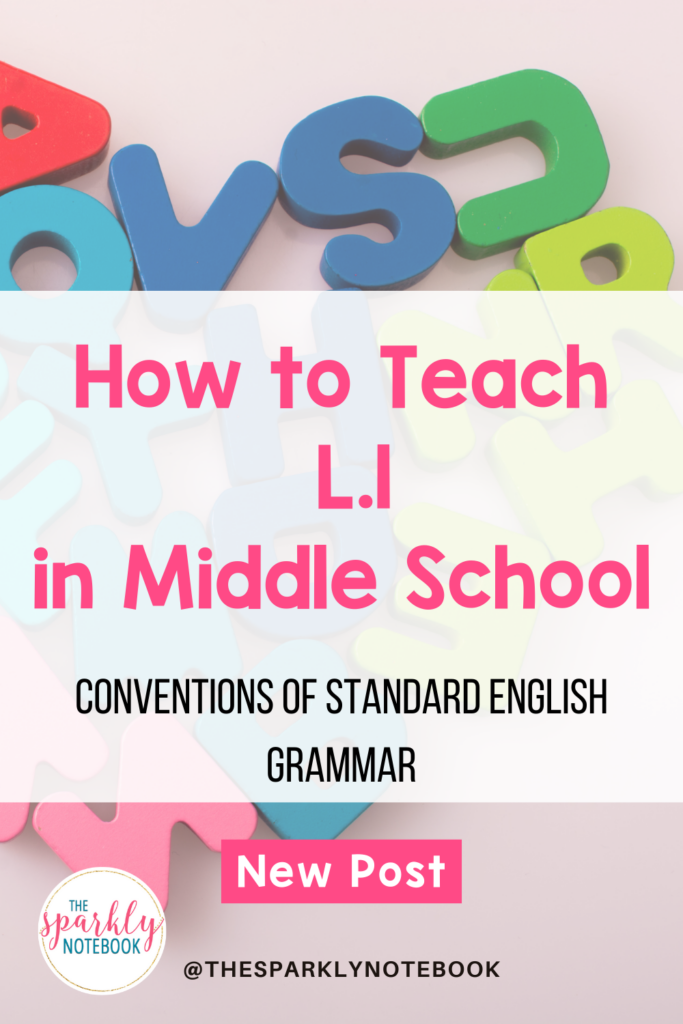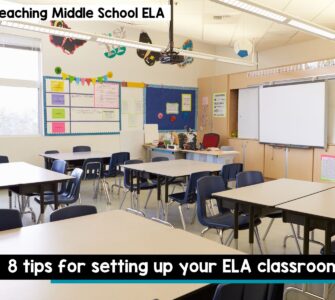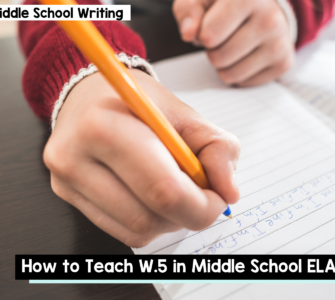A breakdown for teachers who teach L.1 in middle school ELA. In this post, we’ve included learning targets, concept breakdowns, resource suggestions, and activity and assessment ideas!
L.1 is both a teacher’s best friend and enemy as this is when we start the unending battle or ‘if a computer can fix it for us, then why…’ questions.
Ever since spell check started coming on the scene and now AI tools like Grammarly and others, students (and some adults) don’t think it is as important to know and understand rules and standard conventions of English grammar; however, we see every day why knowing basic conventions is so important.
It becomes obvious in that quick social media post you created that is now being shared 1000s of times because you used the wrong kind of there.
It is in the picture the person took of the note on your lunch that had no capitalization.
It is when you are expected to write a handwritten note to a coworker, fill in a writing portion of a physical application, or quickly reply to an email, and your usual grammar and spelling tools are not available to you.
We have a connotation that follows us around that says if you know grammar rules and conventions, then you are ‘educated.’ You are ‘smart.’ You are ‘trustworthy.’ You value ‘an attention to detail.’
Knowing these rules and spending time practicing them can help students be more confident about their writing, make them more sure of themselves, and generally help them have a better appreciation for the time and effort it takes to write professionally.
Today, we are discussing the first Language standard in the Common Core, L.1.
As we start talking about how to teach L.1 in middle school, let’s start with the learning targets!

Learning Targets
By focusing on learning targets, we can model our lessons to hit on very specific goals and skills. In this post, we talk about how we break down each standard and make a plan for learning, practicing, and reviewing the standards throughout the year using the checklists below.
By breaking the standards down into learning targets, and then lining them up alongside their closest grade levels, we can see the nuances of the standard more clearly.
Here are the learning targets on which we developed our resources for L.1.
Teaching L.7.1 (7th Grade)

7th Grade Standard: Demonstrate command of the conventions of standard English grammar and usage when writing or speaking.
7th Grade Learning Targets
- I can explain the function of phrases and clauses in general and their function in specific sentences.
- I can choose among simple, compound, complex, and compound-complex sentences.
- I can place phrases and clauses within a sentence, recognizing and correcting misplaced and dangling modifiers.
Teaching L.8.1 (8th Grade)

8th Grade Standard: Demonstrate command of the conventions of standard English grammar and usage when writing or speaking.
8th Grade Learning Targets
- I can explain the function of verbals in particular sentences.
- I can form and use verbs in the active and passive voice.
- I can use the following verb moods correctly – indicative, imperative, interrogative, conditional, and subjunctive.
- I can recognize and correct inappropriate shifts in verb voice and mood.
Growing through Middle School: Prioritizing is Key
When you are considering how to teach L.1 in middle school, it helps to think about all of the different language skills that a student needs to know and create a list.
Then, from that list, prioritize which conventions and language rules students need to know first. In other words, which conventions grow on each other?
As you can see in the learning targets listed above, we start our focus in 7th grade on mastering the difference between clauses and phrases and different sentence structures before focusing on voice and mood in 8th grade.
We feel that learning about and avoiding incomplete sentences is incredibly important, and should be mastered before starting to worry about things like passive and active voice.
Reviewing test questions for each grade level can also be helpful when trying to figure out which conventions of writing and speaking you’ll teach when, and further diving into the state tests and convention lists will help you figure out which skills to focus on, and which skills can be saved for later.
Resources for teaching L.1
When picking resources to help teach L.1, you’ll want to make sure the resource teaches, practices, and reviews the standard at the appropriate level for the students you’re teaching.
Each of our resources for this standard works through the standard and learning targets listed above using grade-level-specific passages and activities that help the student develop the standard completely.
The resources include a lesson/activity for each specific learning target or concept and also include assessments, posters, and answer keys.
Activities and Projects for Practicing and Assessing L.1 in Middle School
- Phrases and clauses can be really confusing for students, but with practice, they can become masters at identifying them. Thus, they will be less likely to write in incomplete sentences. We have some lessons designed around identifying clauses and phrases in the 7th-grade unit.
- Start with the lesser-known parts of speech, like verbals. By focusing on the verbals like gerunds, participles, and infinitives, students start to see how sentences are constructed and the different ways verbs can be represented in a sentence. We have several worksheets dedicated to verbals in the 8th-grade unit.
- I love teaching sentence structures and sentence patterns. When ‘math-minded’ students realize that writing and language actually has formulas, they go nuts! Make sure to explain sentence structure and sentence patterns when teaching the L.1 standard at any grade level.
- The summative assessment for our 7th-grade unit includes sections that assess…
- Identifying clauses and phrases
- Phrase modifiers
- Writing in different sentence structures
- Identifying misplaced and dangling modifiers
There are really so many different ways you can work on and assess the L.1 standard because knowing conventions and structures of sentences can really be assessed alongside of any other standard. I strongly suggest using our 7th and 8th grade L.1 resources to teach and practice these convention rules, but practice and review the standard when you are working on writing or by having students identify these conventions in their close read passages or paired passages.
It is hard to know that your students are understanding and mastering the standards. The challenge in middle school ELA is a big one, but when you start with these standards-focused resources and then grow from there, you know that students are being exposed to every learning target they are expected to be able to achieve throughout the year.
 How to teach RI.6 in Middle School
How to teach RI.6 in Middle School  8 tips for setting up your ELA classroom
8 tips for setting up your ELA classroom How to teach W.5 in Middle School ELA
How to teach W.5 in Middle School ELA